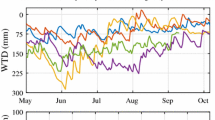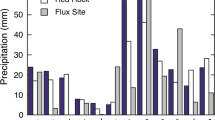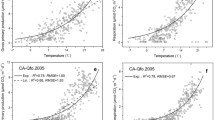Abstract
Climate change may alter the terrestrial ecosystem carbon balance in the Arctic, and previous studies have emphasized the importance of cold season gas exchange when considering the annual carbon balance. Here, we examined gross ecosystem production (GEP), ecosystem respiration (R eco) and net ecosystem exchange (NEE) during autumn at a high arctic dry open heath, over a period where air temperatures decreased from +9.8 to −16.5°C. GEP declined by 95–100% during autumn but GEP significantly different from 0 was measured on October 8 despite sub-zero temperatures. R eco declined by 90% and dominated NEE throughout the study as the ecosystem on all measurement days was a source of atmospheric CO2. We estimated net September carbon losses (NEE) to be 17 g CO2 m−2, emphasizing the importance of autumn in relation to annual carbon budgets. The study site has been subjected to 14 summers of water addition, and occasional pulses of nitrogen (N) addition in a fully factorial design. N addition enhanced GEP up to 17-fold during September, although there was no effect in October when GEP was very low. Summer water addition decreased autumn R eco by up to 25%. Both N amendment and water addition decreased carbon loss, that is, increased NEE; N amendment increased NEE on all dates by 13–64% whereas water addition increased NEE by 20–54% late in September and onward, demonstrating the importance of nutrient and water availability on carbon balance in high arctic tundra, also during the autumn freeze-in.


Similar content being viewed by others
References
ACIA. 2005. Arctic Climate Impact Assessment. Cambridge: Cambridge University Press.
Arft AM, Walker MD, Gurevitch J, Alatalo JM, Bret-Harte MS, Dale M, Diemer M, Gugerli F, Henry GHR, Jones MH, Hollister RD, Jonsdottir IS, Laine K, Levesque E, Marion GM, Molau U, Molgaard P, Nordenhall U, Raszhivin V, Robinson CH, Starr G, Stenstrom A, Stenstrom M, Totland O, Turner PL, Walker LJ, Webber PJ, Welker JM, Wookey PA. 1999. Responses of tundra plants to experimental warming: meta-analysis of the international tundra experiment. Ecol Monogr 69:491–511.
Arndal MF, Illeris L, Michelsen A, Albert K, Tamstorf M, Hansen BU. 2009. Seasonal variation in gross ecosystem production, plant biomass, and carbon and nitrogen pools in five high arctic vegetation types. Arct Antarct Alp Res 41:164–73.
Björkman MP, Morgner E, Bjork RG, Cooper EJ, Elberling B, Klemedtsson L. 2010a. A comparison of annual and seasonal carbon dioxide effluxes between sub-Arctic Sweden and High-Arctic Svalbard. Polar Res 29:75–84.
Björkman, MP, Morgner, E, Cooper, EJ, Elberling, B, Klemedtsson, L, Bjork, RG. 2010b. Winter carbon dioxide effluxes from Arctic ecosystems: an overview and comparison of methodologies. Global Biogeochemical Cycles 24.
Bliss LC, Matveyeva NV. 1992. Circumpolar arctic vegetation. In: Chapin FC, Jefferies RL, Reynolds JF, Shaver GR, Svoboda J, Eds. Arctic ecosystems in a changing climate: an ecophysiological perspective. San Diego: Academic Press. pp 59–89.
Chapin FS, Shaver GR, Giblin AE, Nadelhoffer KJ, Laundre JA. 1995. Responses of Arctic Tundra to experimental and observed changes in climate. Ecology 76:694–711.
Christensen TR, Friborg T, Sommerkorn M, Kaplan J, Illeris L, Soegaard H, Nordstroem C, Jonasson S. 2000. Trace gas exchange in a high-arctic valley 1. Variations in CO2 and CH4 flux between tundra vegetation types. Global Biogeochem Cycles 14:701–13.
Clein JS, Schimel JP. 1995. Microbial activity of Tundra and Taiga soils at subzero temperatures. Soil Biol Biochem 27:1231–4.
Douma JC, Van Wijk MT, Lang SI, Shaver GR. 2007. The contribution of mosses to the carbon and water exchange of arctic ecosystems: quantification and relationships with system properties. Plant Cell Environ 30:1205–15.
Elberling B. 2007. Annual soil CO2 effluxes in the High Arctic: the role of snow thickness and vegetation type. Soil Biol Biochem 39:646–54.
Elberling B, Brandt KK. 2003. Uncoupling of microbial CO2 production and release in frozen soil and its implications for field studies of arctic C cycling. Soil Biol Biochem 35:263–72.
Fahnestock JT, Jones MH, Brooks PD, Walker DA, Welker JM. 1998. Winter and early spring CO2 efflux from tundra communities of northern Alaska. J Geophys Res 103:29023–7.
Fahnestock JT, Jones MH, Welker JM. 1999. Wintertime CO2 efflux from arctic soils: implications for annual carbon budgets. Global Biogeochem Cycles 13:775–9.
Grogan P, Chapin FS. 1999. Arctic soil respiration: effects of climate and vegetation depend on season. Ecosystems 2:451–9.
Grogan P, Jonasson S. 2003. Controls on annual nitrogen cycling in the understory of a subarctic birch forest. Ecology 84:202–18.
Grogan P, Jonasson S. 2005. Temperature and substrate controls on intra-annual variation in ecosystem respiration in two subarctic vegetation types. Glob Change Biol 11:465–75.
Grogan P, Jonasson S. 2006. Ecosystem CO2 production during winter in a Swedish subarctic region: the relative importance of climate and vegetation type. Glob Change Biol 12:1479–95.
Grogan P, Illeris L, Michelsen A, Jonasson S. 2001. Respiration of recently-fixed plant carbon dominates mid-winter ecosystem CO2 production in sub-arctic heath tundra. Climatic Change 50:129–42.
Hansen BU, Sigsgaard C, Rasmussen L, Cappelen J, Hinkler J, Mernild SH, Petersen D, Tamstorf MP, Rasch M, Hasholt B. 2008. Present-day climate at Zackenberg. Adv Ecol Res 40:111–49.
Hobbie SE, Chapin FS. 1998. Response of tundra plant biomass, aboveground production, nitrogen, and CO2 flux to experimental warming. Ecology 79:1526–44.
Hobbie SE, Schimel JP, Trumbore SE, Randerson JR. 2000. Controls over carbon storage and turnover in high-latitude soils. Glob Change Biol 6:196–210.
Hooper DU, Cardon ZG, Chapin FS, Durant M. 2002. Corrected calculations for soil and ecosystem measurements of CO2 flux using the LI-COR 6200 portable photosynthesis system. Oecologia 132:1–11.
Illeris L, Michelsen A, Jonasson S. 2003. Soil plus root respiration and microbial biomass following water, nitrogen, and phosphorus application at a high arctic semi desert. Biogeochemistry 65:15–29.
Illeris L, Christensen TR, Mastepanov M. 2004a. Moisture effects on temperature sensitivity of CO2 exchange in a subarctic heath ecosystem. Biogeochemistry 70:315–30.
Illeris L, Konig SM, Grogan P, Jonasson S, Michelsen A, Ro-Poulsen H. 2004b. Growing-season carbon dioxide flux in a dry subarctic heath: responses to long-term manipulations. Arct Antarct Alp Res 36:456–63.
IPCC. 2007. Climate Change 2007: The physical science basis. Contribution of Working Group I to the Fourth Assessment Report of the Intergovernmental Panel on Climate Change. Cambridge: Cambridge University Press.
Jensen LM, Rasch M. 2010. Zackenberg Ecological Research Operations, 15th Annual Report, 2009. Denmark: National Environmental Research Institute, Aarhus University.
Jones MH, Fahnestock JT, Walker DA, Walker MD, Welker JM. 1998. Carbon dioxide fluxes in moist and dry arctic tundra during season: responses to increases in summer temperature and winter snow accumulation. Arct Alp Res 30:373–80.
Jones MH, Fahnestock JT, Welker JM. 1999. Early and late winter CO2 efflux from arctic tundra in the Kuparuk River watershed, Alaska, USA. Arct Antarct Alp Res 31:187–90.
Jones MH, Fahnestock JT, Stahl PD, Welker JM. 2000. A note on summer CO2 flux, soil organic matter, and microbial biomass from different high arctic ecosystem types in northwestern Greenland. Arct Antarct Alp Res 32:104–6.
Larsen KS, Grogan P, Jonasson S, Michelsen A. 2007a. Respiration and microbial dynamics in two subarctic ecosystems during winter and spring thaw: effects of increased snow depth. Arct Antarct Alp Res 39:268–76.
Larsen KS, Ibrom A, Jonasson S, Michelsen A, Beier C. 2007b. Significance of cold-season respiration and photosynthesis in a subarctic heath ecosystem in Northern Sweden. Glob Change Biol 13:1498–508.
Littell RC, Milliken GA, Stroup WW, Wolfinger RD. 1996. SAS© System for mixed models. Cary (NC): SAS Institute Inc.
Longton RE. 1997. The role of bryophytes and lichens in polar ecosystems. In; Woodin SJ, Mawquiss M, Eds. Ecology of arctic environments. Oxford: British Ecological Society, Blackwell Science. pp 69–95.
Marchand FL, Nijs I, Heuer M, Mertens S, Kockelbergh F, Pontailler JY, Impens I, Beyens L. 2004. Climate warming postpones senescence in High Arctic tundra. Arct Antarct Alp Res 36:390–4.
Michaelson, GJ, Ping, CL. 2003. Soil organic carbon and CO2 respiration at subzero temperature in soils of Arctic Alaska. Journal of Geophysical Research-Atmospheres 108.
Mikan CJ, Schimel JP, Doyle AP. 2002. Temperature controls of microbial respiration in arctic tundra soils above and below freezing. Soil Biol Biochem 34:1785–95.
Morgner E, Elberling B, Strebel D, Cooper EJ. 2010. The importance of winter in annual ecosystem respiration in the High Arctic: effects of snow depth in two vegetation types. Polar Res 29:58–74.
Nobrega S, Grogan P. 2008. Landscape and ecosystem-level controls on net carbon dioxide exchange along a natural moisture gradient in Canadian low arctic tundra. Ecosystems 11:377–96.
Oechel WC, Vourlitis G, Hastings SJ. 1997. Cold season CO2 emission from arctic soils. Global Biogeochem Cycles 11:163–72.
Oechel WC, Vourlitis GL, Hastings SJ, Zulueta RC, Hinzman L, Kane D. 2000. Acclimation of ecosystem CO2 exchange in the Alaskan Arctic in response to decadal climate warming. Nature 406:978–81.
Olsson PQ, Sturm M, Racine CH, Romanovsky V, Liston GE. 2003. Five stages of the Alaskan Arctic cold season with ecosystem implications. Arct Antarct Alp Res 35:74–81.
Oquist MG, Sparrman T, Klemedtsson L, Drotz SH, Grip H, Schleucher J, Nilsson M. 2009. Water availability controls microbial temperature responses in frozen soil CO2 production. Glob Change Biol 15:2715–22.
Panikov NS, Flanagan PW, Oechel WC, Mastepanov MA, Christensen TR. 2006. Microbial activity in soils frozen to below −39 degrees C. Soil Biol Biochem 38:785–94.
Press MC, Callaghan TV, Lee JA. 1998. How will European Arctic ecosystems respond to projected global environmental change? Ambio 27:306–11.
Robinson CH, Wookey PA, Lee JA, Callaghan TV, Press MC. 1998. Plant community responses to simulated environmental change at a high arctic polar semi-desert. Ecology 79:856–66.
Romanovsky VE, Osterkamp TE. 2000. Effects of unfrozen water on heat and mass transport processes in the active layer and permafrost. Permafrost Periglac Process 11:219–39.
Schimel JP, Bilbrough C, Welker JA. 2004. Increased snow depth affects microbial activity and nitrogen mineralization in two Arctic tundra communities. Soil Biol Biochem 36:217–27.
Schimel JP, Fahnestock J, Michaelson G, Mikan C, Ping CL, Romanovsky VE, Welker J. 2006. Cold-season production of CO2 in arctic soils: can laboratory and field estimates be reconciled through a simple modeling approach? Arct Antarct Alp Res 38:249–56.
Schmidt IK, Jonasson S, Shaver GR, Michelsen A, Nordin A. 2002. Mineralization and distribution of nutrients in plants and microbes in four arctic ecosystems: responses to warming. Plant Soil 242:93–106.
Shaver GR, Kummerov J. 1992. Phenology, resource allocation and growth of Arctic vascular plants. In: Chapin FC, Jefferies RL, Reynolds JF, Shaver GR, Svoboda J, Eds. Arctic ecosystems in a changing climate: an ecophysiological perspective. San Diego: Academic Press. pp. 193–211.
Sjögersten S, van der Wal R, Woodin SJ. 2006. Small-scale hydrological variation determines landscape CO2 fluxes in the high Arctic. Biogeochemistry 80:205–16.
Sorensen PL, Michelsen A, Jonasson S. 2008. Nitrogen uptake during one year in subarctic plant functional groups and in microbes after long-term warming and fertilization. Ecosystems 11:1223–33.
Starr G, Oberbauer SF. 2003. Photosynthesis of arctic evergreens under snow: implications for tundra ecosystem carbon balance. Ecology 84:1415–20.
Stendel M, Christensen JH, Petersen D. 2008. Arctic climate and climate change with a focus on Greenland. Adv Ecol Res 40:13–43.
Strebel D, Elberling B, Morgner E, Knicker HE, Cooper EJ. 2010. Cold-season soil respiration in response to grazing and warming in High-Arctic Svalbard. Polar Res 29:46–57.
Tilston EL, Sparrman T, Oquist MG. 2010. Unfrozen water content moderates temperature dependence of sub-zero microbial respiration. Soil Biol Biochem 42:1396–407.
Walker DA, Raynolds MK, Daniels FJA, Einarsson E, Elvebakk A, Gould WA, Katenin AE, Kholod SS, Markon CJ, Melnikov ES, Moskalenko NG, Talbot SS, Yurtsev BA, Team C. 2005. The circumpolar Arctic vegetation map. J Veg Sci 16:267–82.
Welker JM, Brown KB, Fahnestock JT. 1999. CO2 flux in Arctic and alpine dry tundra: comparative field responses under ambient and experimentally warmed conditions. Arct Antarct Alp Res 31:272–7.
Welker JM, Fahnestock JT, Jones MH. 2000. Annual CO2 flux in dry and moist arctic tundra: field responses to increases in summer temperatures and winter snow depth. Climatic Change 44:139–50.
Welker JM, Fahnestock JT, Henry GHR, O’Dea KW, Chimner RA. 2004. CO2 exchange in three Canadian High Arctic ecosystems: response to long-term experimental warming. Glob Change Biol 10:1981–95.
Wookey PA, Welker JM, Parsons AN, Press MC, Callaghan TV, Lee JA. 1994. Differential growth, allocation and photosynthetic responses of Polygonum viviparum to simulated environmental-change at a high arctic polar semidesert. Oikos 70:131–9.
Wookey PA, Robinson CH, Parsons AN, Welker JM, Press MC, Callaghan TV, Lee JA. 1995. Environmental constraints on the growth, photosynthesis and reproductive development of Dryas octopetala at a high Arctic Polar Semidesert, Svalbard. Oecologia 102:478–89.
Zimov SA, Davidov SP, Voropaev YV, Prosiannikov SF, Semiletov IP, Chapin MC, Chapin FS. 1996. Siberian CO2 efflux in winter as a CO2 source and cause of seasonality in atmospheric CO2. Climatic Change 33:111–20.
Acknowledgments
This work was supported by the Danish Council for Independent Research | Natural Sciences, and the Danish National Research Foundation. We thank Charlotte Sigsgaard, Line Kyhn, Sebrina Burchard and Jørgen Skafte for assistance in the field. Aarhus University is thanked for access to and logistics at Zackenberg. We would like to thank Gaius Shaver and two anonymous reviewers for their constructive comments on an earlier version of the manuscript.
Author information
Authors and Affiliations
Corresponding author
Additional information
Author Contributions
A. Michelsen, C. T. Christiansen—conceived of or designed study; C. T. Christiansen—performed research and contributed new methods or models; C. T. Christiansen, A. Michelsen, N. M. Schmidt—analyzed data and wrote the paper.
Rights and permissions
About this article
Cite this article
Christiansen, C.T., Schmidt, N.M. & Michelsen, A. High Arctic Dry Heath CO2 Exchange During the Early Cold Season. Ecosystems 15, 1083–1092 (2012). https://doi.org/10.1007/s10021-012-9569-4
Received:
Accepted:
Published:
Issue Date:
DOI: https://doi.org/10.1007/s10021-012-9569-4




